In this article we are reviewing Whites TM 808 metal detector. This is an excellent deep search metal detector model, which is also rather affordable. This device was created for industrial purposes. However, treasure hunting amateurs tend to use it to search for large metal targets in the ground.
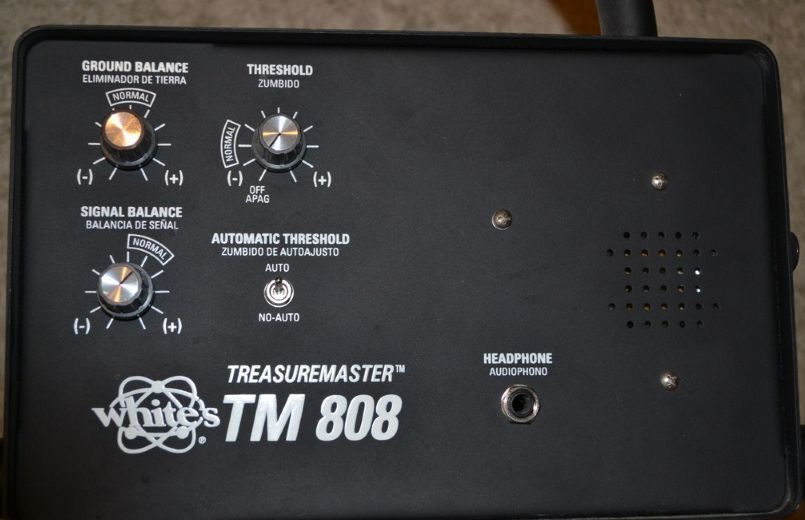
Contents
What was the device designed for?
Deep search metal detectors are designed for detecting large sized objects located quite deep in the ground.
Deep search metal detector Whites TM 808 is one of the best in this area and its main advantage is that it has two separate coils: a receiving and a transmitting one.
Besides, the discrimination function in such devices is based on a target size, not on the target metal type.
| Model | Whites TM 808 |
| Weight | 5.7 lbs |
| Length (Adjustable) | 38″-19″ |
| Batteries | 4 type C |
| Headphones | No |
| Warranty | 2 years |
| Operating Principle | VLF |
| Standard Searchcoil | Deep-seeking dual antenna |
| Operating Frequencies (kHz) | 6.5 |
| Water resistance | No |
| Submersion Depth | No |
| Discrimination | No |
| Ground Balance | manual |
| Search Modes | 1 |
| Audio Threshold | Yes |
| Electronic Pinpointing | Yes |
| VDI (0 to 99 scale) | No |
| Build-in flashlight | No |
The review
The shaft
White’s TM808 became sort of a legend long time ago. It has two searchcoils, which enables working with large sized metal objects located up to 20 feet (6 meters) deep.
Actually, 20 feet detection depth is something unreal, since such a result is achievable only in a scientific laboratory conditions. However, real detection depth values are still quite impressive, since no one is going to dig a pit 10 feet deep anyway.
The metal detector weights 5.7 lbs, that’s why newbie detectorists may find it challenging to use the device at first.
You can confidently use the device both on some flat ground (fields) and on areas with some ground level differences (various entrenchments, field emplacements, etc.) and in forests.
The basic thing of the device design is a stiff connection of the metal detector case and the handle as well as relatively small length of the device shaft. In general the above mentioned creates stable distance from the searchcoils to the ground and, correspondingly, decreases the number of false signals received.
In time TM 808 starts to receive some phantom signals due to not rigid enough connection between the shaft and the coil. The coils (more often the front one) connection to the shaft becomes loose and even the slightest change of their relative position causes a phantom signal appearance.
A rubber strap will also be helpful: when applied on the metal detector case it serves to prevent the headphones plug from pulling out from the jack while working on bushy areas.
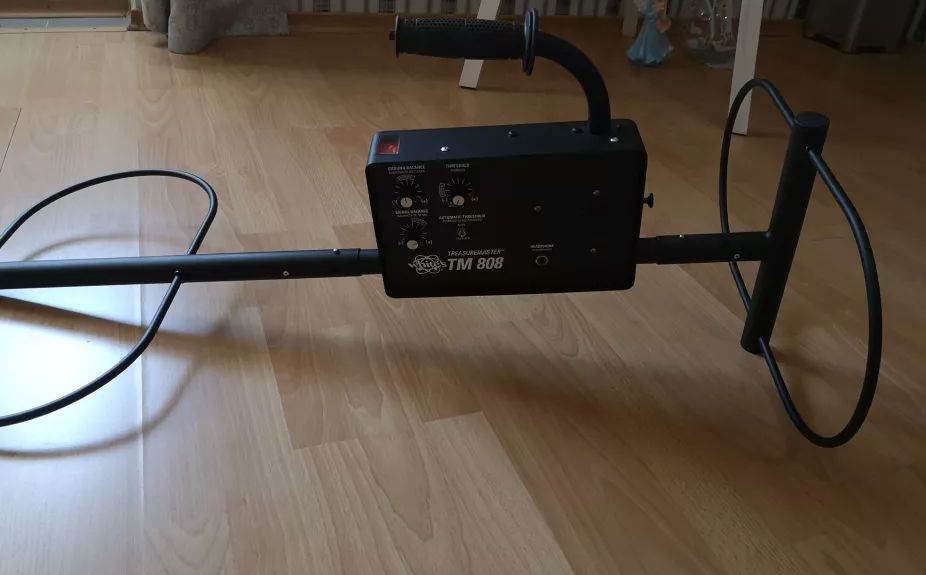
The searchcoil
White’s TM808 metal detector uses VLF approach and Blue Maxx Technology Antennas. The device has two search coils (Dual Antenna): one of them sends signals and the other one receives, the control unit is located between them.
The device uses only one operating frequency 6,59 kHz. Low frequencies allow detection depth increasing and thus improving the ground balance significantly.
The headphones
The device has an opportunity to use headphones while detecting. There is a special jack for them, though the headphones aren’t included into the device package set.
The battery
Four C type cassette batteries or White’s accumulator batteries are used as the device power supply. One battery set is enough for 12 hours of continuous searching.
The control unit
It’s design is very simple: several potentiometers are used to adjust the metal detector.
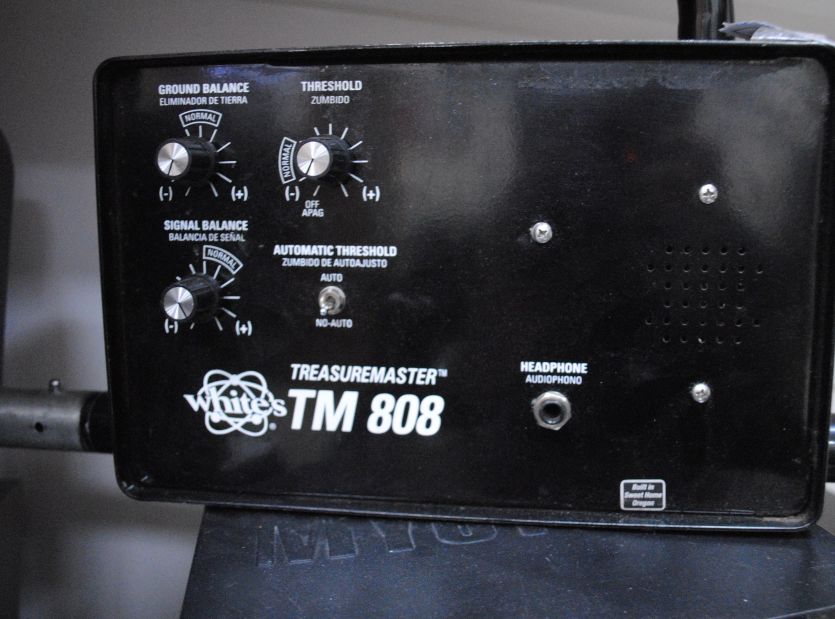
Threshold
This is a potentiometer responsible for the threshold tone adjustment, it also turns the device on/off. To turn TM-808 on, turn the handle clockwise till you feel and hear a click. If you continue turning the handle, you will increase the volume of the threshold tone.
Please, keep in mind that, that the device demonstrates maximum performance efficiency when the threshold tone is at audible limit, when you just hear a slight noise.
Also, this adjustment is responsible for battery charge indicator. When you turn on the metal detector, pay attention to the scale of the battery charge indicator. The arrow should move to the right and stop in the upper section of the yellow sector of the scale for several seconds.
In this case, the battery charge is enough for the device to function normally. If the arrow is lower than the yellow segment of the scale, you should replace the batteries to continue treasure hunting.
Signal balance
This potentiometer is responsible for intensity of the signal received by the device. For beginner detectorists we highly recommend to set the signal balance in ‘normal’ position, since such an adjustment will do for most areas with standard search conditions.
According to the user’s manual, it’s advised to shift this setting to the negative positions (marked as ‘-’) only when the noise distorts the threshold tone.
Sources of such noise may be highly mineralized soils, electrical power transmission lines, radio, mobile phones, etc.
On the other hand, if the noise level is low, you can switch the potentiometer to the positive position (marked as ’+’).
Ground balance
Proper ground balancing is a key to success in achieving maximum detection depth.
However, if you are a beginner detectorist, I recommend you to set the ground balance switcher to “normal” position, since for most of common soil types this will be quite enough.
The most important thing you should know about the ground balance is that the better the device is adjusted to your current search conditions, the less noise you receive from mineralized soils.
Highly mineralized soil is the main obstacle when metal detecting and most of beginner detectorists with poorly adjusted metal detectors have troubles exactly at this stage.
Turn the potentiometer handle to the « + » direction if you are scanning a highly mineralized soil; turn it to the « – » direction if level of soil mineralization isn’t high in your area.
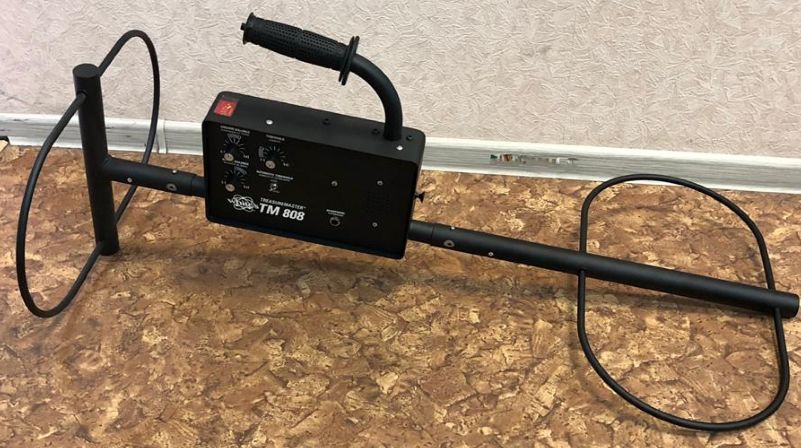
Automatic Threshold
You can set automatic threshold tone by means of the ‘on/off’ switch. When this function is on, the device automatically tries to set maximally efficient level of the threshold tone basing on the soil mineralization level, which you scan.
When automatic threshold isn’t active (it is off), you should constantly press the button on the device handle to maintain the level of the threshold tone.
Push and hold the button for about 3-5 seconds, then let it go.
Due to automatic threshold adjustment, the metal detector can go through larger areas in a quicker mode. You can adjust the threshold tone manually as well, which enables the most precise detection of the target.
Search Modes
The first generation devices had two mechanisms of search mode selection. These are: looking for cavities in static and dynamic modes, as well as similar modes for All metal search.
In White’s TM 808 metal detector, which belongs to the new generation of the devices you can work only in static or dynamic ALL metal mode. The mode of searching for cavities was removed for some reason.
We highly recommend you to read the user’s manual thoroughly since it is a rather detailed one. However, we should mention some peculiarities.
According to the manual, you should put all the control levers to ‘normal’ position, switch the toggle-switch to ‘auto’ mode and then you can start searching.
The metal detector will definitely demonstrate stable performance, but the detection depth won’t vary significantly if compared to other ordinary metal detectors.
Therefore, there is an alternative algorithm of the device adjustment:
1. Switch Auto Ground Balance toggle switcher to “NO-AUTO” position, the signal balance and ground balance should be switched to “NORMAL”, turn the THRESHOLD handler counter clockwise as far as it can go.
2. Turn on the metal detector and push the button on its handler. We’ll need this button later if we continue treasure hunting at the condition of a «reflected signal» (various entrenchments, etc. can be the case). There’s no need to readjust the device in case of ground level change, it is enough to push this button on the handler.
3. Rise the device about 6-8 inches (15-20 cm) high above the ground. Adjust the ground balance. Find the position of the switch, when the background noise starts to fade.
4. Use the similar algorithm to adjust Signal balance. Search for the position when the signal starts to fade, but it doesn’t disappear at all. You can use a needle indicator for this purpose. Once the adjustment is finished, the needle should point at zero.
6. Check the settings accuracy. Rise the device about 27-30 inches (70-80 cm) above the ground. There should be no signals. If you are still receiving some signals, make sure that they disappear by carefully rotating the Ground Balance adjuster.
IMPORTANT!
During the adjustment process there must be no metal objects within a radius of 3-4 meters. It is highly recommended that the user take keys, mobile, etc. from his pockets. If you are wearing a waist belt, it’s desirable to be the one without a metal belt buckle.
It’s advisable to go treasure hunting when the switch is at ‘NO AUTO’ position. This will ensure more significant detection depth, that when the latter is at ‘AUTO’ position.
Using ‘AUTO’ mode is recommended when it is necessary to define the target center. This is easy to do: toggle the switch, push the button on the handler. The strongest signal will be received from the target center located under the front searchcoil.
You shouldn’t use this mode excessively, since it is directly relevant to ground balance function. If there are some metal objects within the device ‘visibility’ radius, it will take signals received from them as an increase of soil mineralization level and automatically will try to suppress them and the device sensitivity level won’t benefit from this. If such a situation occurs, toggle the switch to ‘NO AUTO’ and push the button on the metal detector handler.
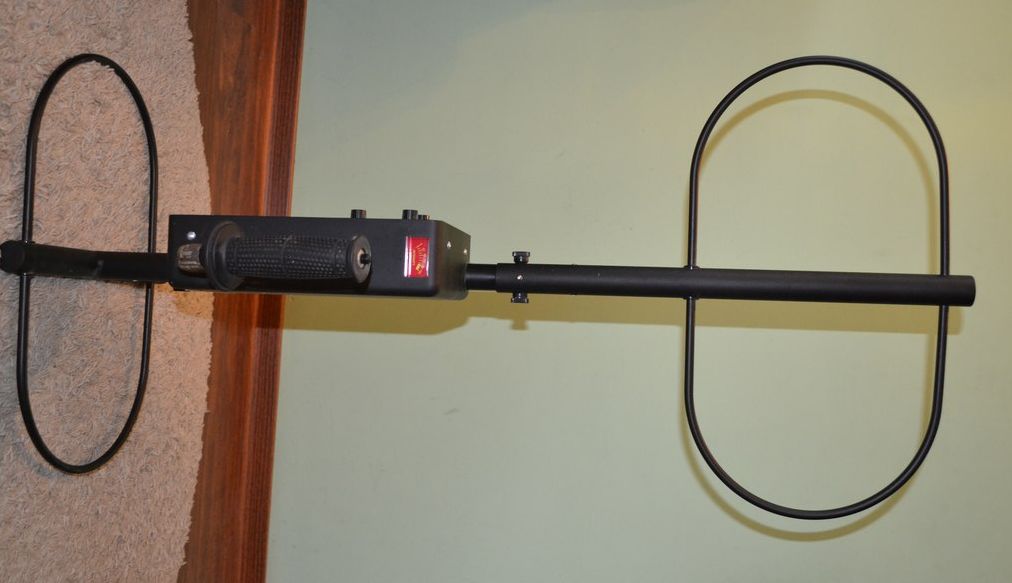
Discrimination
Let’s mention, that most of deep search metal detectors don’t have a discrimination function, so there is no way to define whether you’ve detected a ferrous or non-ferrous target.
Actually, discrimination function is not needed, since a treasure hunting process itself implies digging all the signals received. If a treasure is buried deep in the ground, it’s more likely that the coins are put into something made from iron – a bucket or a bowl.
Conclusions
Whites TM 808 metal detector is for those who clearly understand why they need exactly this device. It is useless when hunting for coins, but when looking for large sized targets this a perfect choice.
The device is relatively light-weighted and small sized; its construction is simple and reliable.